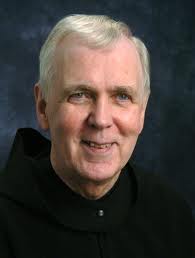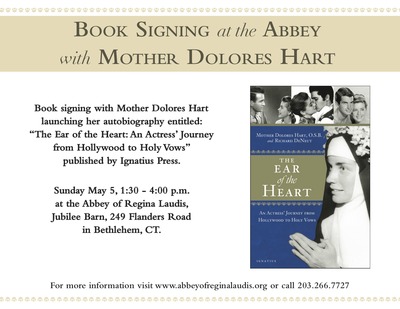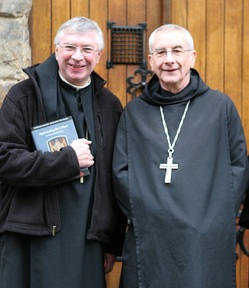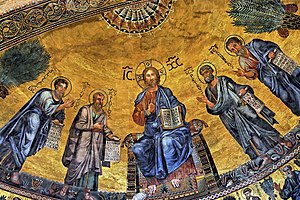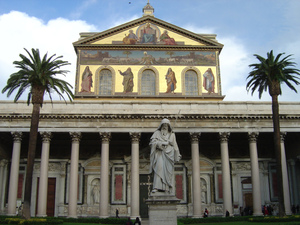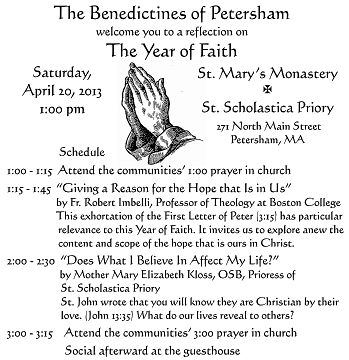Ultimate questions are critical for all persons. And so much for Christians because of the Incarnation of God in human history. What does it mean to believe? What can science teach us? Is using technology a helpful tool in knowing our Christian self? In a Year of Faith presentation on April 20, the topic at hand was “Does What I Believe In Affect My Life?”
Tag: Benedictine
Kevin Seasoltz, OSB, RIP
Father Kevin Seasoltz OSB died early today, 27 April 2013, at Saint John’s Abbey, Collegeville, MN.
Father Kevin was born in Johnstown, Pennsylvania, 29 December 1930. He became a priest of the Diocese of Altoona-Johnstown, 3 June 1956. In 1958, he earned a license in canon law from the Lateran University with a concentration in liturgical law. After earning a degree in canon law, again with an emphasis on liturgical law, from The Catholic University of America, in 1962, he taught in the Religious Studies department until 1987. He professed vows as a monk of Saint Anselm’s Abbey, Washington, DC, 13 November 1960. He later transferred his monastic vow of stability to the Saint John’s Benedictine abbey after spending time on a working sabbatical. In 2009, the Federation of Diocesan Liturgical Commissions honored Dom Kevin with the Frederick R. McManus Award.
Father Kevin was a professor of theology and a very well published author. For many years Dom Kevin served as editor of the revered Worship magazine, a quarterly of opinion.
In the last months he’s been living with cancer; he received the sacraments of the Church on Friday. May Father Kevin rest in peace.
The Ear of the Heart by Mother Dolores Hart
Praying for the abbot in the Eucharistic Prayer at Mass?
Frequently do I go to places where certain liturgical practices catch my attention because of the novelty of what is said and heard. We always need a deeper understanding, a profound appreciation for the prayer of the Church as expressed in the sacred Liturgy. Some will say that canon law, particularly liturgical law, is the bad side of the Good News. As Catholics we are part of a Church; as Catholics we are not independent of sacred Scripture, sacred Tradition and the sacred Magisterium; as Catholics we follow a guided companionship on a journey to a deeper communio with the Triune God. We are not Marlboro people; we are, in fact, sheep in flock called to the Holy Synaxis, to the holy in-gathering of a people in Christ, or simply, Church. We have a good shepherd in Jesus and in His successors, that is, the bishops, and we follow the teaching authority of the Christ and His vicars.
This is a long introduction to a question as whether or not priests of monastic communities ought to name the abbot in the Eucharistic Prayer. There seems to be some confusion over this seemingly small, trite matter. It is not small, and it is not trite. We have an ecclesiology, and we have a liturgical practice that ought to be followed because we live our Catholic lives in communion with others. Abbots are minor prelates; they exercise their pastoral authority and power in their monastic community and not in a diocese, and by extension to the dependent priories. An abbot ought not employ the attitude of having a mitre and a crosier so that you can do whatever you’d like, whenever you’d like, etc.
Can a priest commemorate Abbot X (or even the abbess if in the context of a woman’s monastery) along with the pope and the bishop in the Eucharistic Prayer at Mass?
The General Instruction of the Roman Missal gives four titles that may be named in the Eucharistic Prayer: “The Diocesan Bishop, or one who is equivalent to the Diocesan Bishop in law, must be mentioned by means of this formula: together with your servant N., our Pope, and N., our Bishop (or Vicar, Prelate, Prefect, Abbot)” (no. 149). Each of these offices are “equivalent to the Diocesan Bishop in law” by virtue of their appointment to act on behalf of the Supreme Pontiff within a particular area.
Continue reading Praying for the abbot in the Eucharistic Prayer at Mass?
Francis outside the Walls: called to proclaim, witness, worship God
At the Mass offered by Pope Francis at the Basilica of St Paul outside the Walls today reminded us that “we must obey God”! Francis asked, do we know how to speak of Christ today?
Benedictines and Jesuits converge
Last Sunday, Pope Francis, as the bishop of Rome, took possession of his cathedral church, Saint John Lateran. This coming Sunday, 14 April, Pope Francis will take possession of the Papal Basilica of Saint Paul’s outside the Walls in Rome.
A concelebrated Mass will be offered by the Pope, the archpriest, James Cardinal Harvey and the Benedictine monks to whom the pastoral care of the Basilica and the adjoining Monastery are entrusted. The monks are led by Abbot Edmund Power, OSB. He gives an interview to Vatican Radio (be aware, some of the abbot’s facts are wrong).
There is a historical connection between the Benedictines and the Jesuits. True the Benedictines about 1000 years old than the Jesuits but the historical part goes a bit deeper. The Pilgrim, as he was known, went to the Benedictine abbey of Our Lady of Montserrat in Spain, to make a general confession, keep an all-night in vigil before Our Lady’s altar, and to observe the rites of chivalry in preparation for his new life of being a converted sinner. There Ignatius left his sword and knife at the altar of the Black Madonna, he disposed of his fine clothes to a poor man, and adopted rough clothes with sandals and a staff of a pilgrim.
Popes who belonged to religious orders
Pope Gregory XVI, a Benedictine monk, made gambling on papal elections punishable by excommunication.
When Jorge Mario Bergoglio was elected the 266th Roman Pontiff he was listed among a rather small and elite group of men who had their intellectual and spiritual formation in religious life. Bergoglio is a member of the Society of Jesus. But who are the others?
Gregory I, Boniface IV, Adeodatus II, Leo IV, John IX, Leo VII, Stephen IX, Gregory VII, Victor, III, Urban II, Paschal II, Gelasius, II, Celestine V, Clement VI, Urban V, Pius VII, Gregory XVI
Honorius II, Innocent II, Lucius II, Adrian IV, Gregory VIII, Eugene IV
Nicholas IV, Sixtus IV, Sixtus V, Clement XIVSecular Franciscans have 2Pius IX, Leo XIII
Innocent V, Benedict XI, Pius V, Benedict XIII
Eugene III, Benedict XII
Paul IV
Francis
St Mary’s Monastery (Petersham) hosts Fr Robert Imbelli for a Year of Faith presentation on Hope
Novena of Prayer to Saint Benedict, Day 1
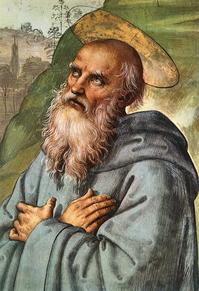 Today begins nine days of prayer to Saint Benedict, ending at First Vespers of Saint Benedict’s Transitus (March 20). On March 21, many Benedictine monasteries around the world will observe the death of Benedict (+547) with solemnity, if you follow another liturgical calendar other than the Roman one, while other monasteries will celebrate July 11 as a feast, the translation of Benedict’s bones.
Today begins nine days of prayer to Saint Benedict, ending at First Vespers of Saint Benedict’s Transitus (March 20). On March 21, many Benedictine monasteries around the world will observe the death of Benedict (+547) with solemnity, if you follow another liturgical calendar other than the Roman one, while other monasteries will celebrate July 11 as a feast, the translation of Benedict’s bones.
Cultivating Peace –the Benedictine way
You be interested in this video presentation, “Cultivating Peace in One’s Own Life and in Society” by Abbot James Wiseman of St Anselm’s Abbey (Washington, DC).
PAX!
